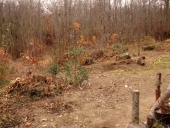
 2
2




 3
3




 3
3




Creating edible biodiversity and embracing everlasting abundance.
 1
1




 1
1




 3
3




Standing on the shoulders of giants. Giants with dirt under their nails





 1
1




Jack Edmondson wrote:I have a question about using mycrorrhizal fungi inoculant on roots of both trees and annuals. The scenario is a primary orchard in a silvopasture/agriforst design. The trees will be planted in a swale system (on contour, of course.) The swales will be about 60 feet apart. The trees will be inoculated when planted. The strips between swales will be pasture with nitrogen fixing deep rooted species, to fight compaction and improve nitrogen content.
My question is: If both the trees and vegatation is inoculated to form there own colonies, I am hoping for more rapid improvement in all plant growth and soil health. However, I don't know if I am setting up competing networks (although they will take years to reach one another); or if they will fill in and become symbiotic to one another? The concern is my trees are of primary importance. This is first and foremost an orchard, with the plant life - livestock cycle improving overall health of the soil; and accelerating soil regeneration to support the trees.
Bonus question: I have heard many people advocate root pruning agriforests to keep the trees from competing with intercrop species. That seems intuitive from a traditional agricultural aspect; but counter to good permaculture. By pruning the roots, one breaks the fungal network, limiting the benefit of the key mycelium network. I would think a more appropriate permaculture response would be let the forest be a savanah and don't disturb the network the plants decide is appropriate.
Thoughts from the fungi experts?
List of Bryant RedHawk's Epic Soil Series Threads We love visitors, that's why we live in a secluded cabin deep in the woods. "Buzzard's Roost (Asnikiye Heca) Farm." Promoting permaculture to save our planet.
 2
2




Jack Edmondson wrote:However, I don't know if I am setting up competing networks (although they will take years to reach one another); or if they will fill in and become symbiotic to one another?
"Where will you drive your own picket stake? Where will you choose to make your stand? Give me a threshold, a specific point at which you will finally stop running, at which you will finally fight back." (Derrick Jensen)




Standing on the shoulders of giants. Giants with dirt under their nails
















List of Bryant RedHawk's Epic Soil Series Threads We love visitors, that's why we live in a secluded cabin deep in the woods. "Buzzard's Roost (Asnikiye Heca) Farm." Promoting permaculture to save our planet.




Standing on the shoulders of giants. Giants with dirt under their nails

|
Seriously? That's what you're going with? I prefer this tiny ad:
12 DVDs bundle
https://permies.com/wiki/269050/DVDs-bundle
|






